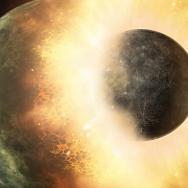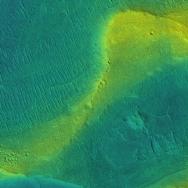Fifty years ago, NASA astronauts stepped off Apollo 11 and delivered what instantly became the most precious rock on Earth: nearly 50 pounds of dust and rock fragments from the surface of the moon.
Suddenly the wildest dreams of geoscientists had come true, as tiny pieces of the first rocks collected on another celestial body made their way to labs across the U.S. for analysis.
“You cannot overstate the value of actually having these samples to study. It was transformative,” said Nicolas Dauphas, professor in the Department of Geophysical Sciences, whose pioneering research studies the isotopic makeup of rocks from Earth and the moon. “Before Apollo 11, the moon was made of cheese.”
But even after half a century of intensive study and discoveries—many of them at the University of Chicago—the moon remains mysterious. Scientists still don’t have a definitive picture of how the moon formed, or even how old it is.
“It’s amazing to still be asking this,” said Nicole Nie, a graduate student working on Apollo samples in Dauphas’ lab.
Later this year, scientists from UChicago and affiliated Argonne National Laboratory hope to get some more clues when they receive a one-of-a-kind package—rocks from the Apollo 15, 16 and 17 missions that NASA sealed for study by future generations. Scientists at Argonne will use powerful X-rays from Argonne’s giant particle accelerator to examine the molecular makeup of the lunar rocks.
Smashing expectations
Earth is dynamic. Plate tectonics are constantly sucking old rock beneath the surface and pushing up new ones. Any given Earth rock can range from four billion years old (some striped rocks in Canada’s Northwest Territories) to hours old (any active volcano).
Not so the moon. It has no plate tectonics, so its surface appears as it was billions of years ago. Because the rock is not constantly being churned and mixed, the soil and rocks that astronauts scooped up varied widely. Some of it was glassy, black beads; others were crumbly and white.
Looking at the makeup of these multicolored rocks, Prof. Joseph Smith concluded in 1969 that the crust of the moon must have been extensively melted by early meteorite impacts. “There had to have been tremendous collisions. There’s no way the moon could have got where it was without melting,” he said in a 1999 interview. “This was heresy in those days.”
Meanwhile, Prof. Robert Clayton analyzed the oxygen in lunar rocks and compared them to Earth soil. His analysis lent credence to the theory that the moon and Earth where somehow related, like siblings in a family.
Rocking the boat
Over time, scientists began to settle on a theory about the moon’s formation. Some giant object, about the size of Mars, smashed into the newly formed Earth billions of years ago. Pieces floating in orbit from the collision eventually solidified into the moon.
But as they took more precise measurements of the composition of the lunar and Earth samples, a troubling conclusion became increasingly clear: The makeup of Earth and moon rocks were much more similar than they should be. Simulations of such a collision show quite definitively that the moon should be mostly formed out of the other object, and it is unlikely that this other object would have the exact same composition as the Earth.
This was a problem: It’s called the lunar isotopic crisis.
Scientists are working on theories that could explain the evidence. Perhaps the impact completely vaporized both the proto-Earth and the aggressive object, and the moon and Earth formed out of the dust. Perhaps some kind of atmosphere allowed exchange between the two bodies as they formed.
Yet other mysteries persist, showing there’s much we don’t understand. For example: The moon is more depleted in certain particularly volatile elements than Earth. “We could tell this right away after examining the first lunar samples, but after 50 years, we still don’t know why,” Dauphas said. (Nie is using lunar samples to examine this question).
A precious resource
Dauphas’ lab has a set of lunar rocks from each of the Apollo missions. With them, he and his lab investigate questions—from where and when the Earth got its water to the “paternity” of the moon.
Because some of the tests involve acid or other destructive processes, he and his team carefully calculate how much of the moon samples they will need for each test, and no more. In fact, some of the lunar samples were passed down from Prof. Clayton’s collection when he retired.
“We can get an incredible amount of information from a single grain,” said UChicago graduate student Jennika Greer. "By studying the surface of one particle collected by Apollo 17, we can learn about the environment on the moon and the space weather it’s been subjected to."
One of the tools they use is the Advanced Photon Source, located at nearby Argonne National Laboratory, which produces extremely energetic X-rays that can reveal what rocks look like at the molecular level.
Later this year, however, the Advanced Photon Source will host a special guest—a set of samples saved from the Apollo missions and never before opened.
Considered the most pristine samples ever made available by NASA, these select materials from Apollo missions 15, 16 and 17 have remained hermetically sealed since their collection, either vacuum sealed on the lunar surface, frozen or exposed only to helium and then sealed.
“Leave it to NASA to appreciate that they should store samples unopened because 40-50 years down the line there would be new ways to study them that weren’t available back then,” said Tony Lanzirotti, associate research professor at UChicago’s Center for Advanced Radiation Sources and a project member.
One particularly interesting question they’ll be investigating is what the interior of the moon looked like as it was forming. “These particles would have recorded the types of gases coming out of lunar volcanoes billions of years ago, and we can unlock those with the beamline,” said Steve Sutton, a research professor at UChicago who will be examining the rocks.
Fifty years later, it’s clear how valuable samples from the Apollo missions are to science.
“I can analyze them with entirely different technology today and find new answers to old questions,” Dauphas said. “It’s a good time to be studying the moon. There are a number of open questions, and always new ways to consider them.”
—John Spizzirri at Argonne National Laboratory contributed to this story.

